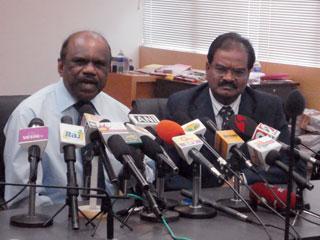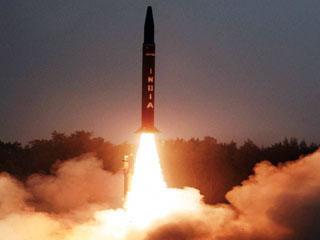
A Sivathanu Pillai, CEO & MD of BrahMos Aerospace & C Swaminathan, Vice-Chancellor, Bharathiar University, addressing mediapersons at the ongoing 'Space Festival 2012.' A Brahmand photo.
COIMBATORE (PTI): The work on launch of submarine variant of supersonic cruise missile BRAHMOS is in the final stages, Dr. A Sivathanu Pillai, CEO & MD Indian-Russian joint venture BrahMos Aerospace, has said.
"Yes we are on the job and it is in the final stages," Dr. Pillai said when asked about the submarine launched-missile at a press conference in Bharathiar University on Thursday.
Sea and ground-launched versions have been successfully tested and put into service with the Indian Army and Navy, he said.
The flight tests of the airborne version will be completed by the end of 2012, he said adding the hypersonic version of BRAHMOS-2 cruise missile will be ready for launch in another five years.
With the research on propulsion of scramjet underway, the hypersonic missile, with four times speed that of the present Supersonic missile, would be ready for induction into Indian forces by 2017.
With a 300 million dollars investment, the Indian-Russian joint venture company, was doing a business of five billion dollars at present, he said.
However, he said the company would think of large scale exports only after meeting the requirements of the Indian armed forces.
Earlier while giving a lecture to young minds on "Space frontier - our next destination " Dr. Pillai said, Defence Research and Development Organisation (DRDO) is exploring the possibilities of developing various concepts like space tourism, setting up of space colony and also bring helium 3 for mass production of energy.
As the technology proved to be successful to reduce the cost of access to space from the earth, it is being explored to generate energy by placing a solar power plant in the orbit, he said.
Space tourism aims to take a round of earth and come back with an affordable price, Dr. Pillai said.
Another major application was to bring helium, the futuristic energy, available in Moon and Mars, he said.
However, for this, there was the need for a "fusion technology", which was yet to be developed and it would be done with a consortium approach along with some countries, in which India was a partner, Dr. Pillai said.
Another concept was to set up a space colony, for which the agency has identified five points, with zero gravity, where earth meets moon, he said.
 Previous Article
Previous Article Next Article
Next Article













The Indian Air Force, in its flight trials evaluation report submitted before the Defence Ministry l..
view articleAn insight into the Medium Multi-Role Combat Aircraft competition...
view articleSky enthusiasts can now spot the International Space Station (ISS) commanded by Indian-American astr..
view article